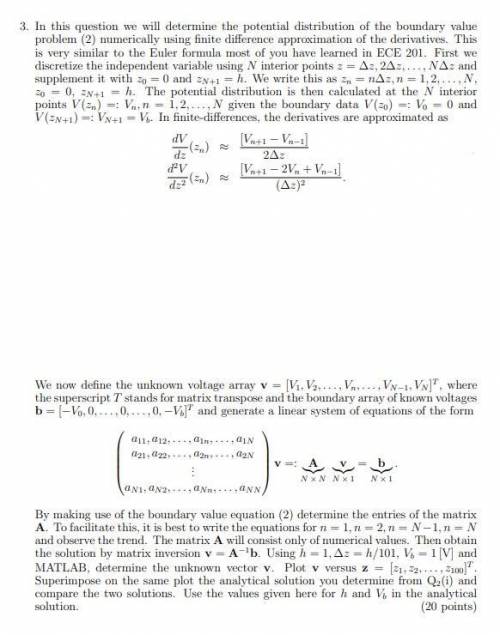
Engineering, 23.02.2022 15:10 chelsey54
In this question we will determine the potential distribution of the boundary value
problem (2) numerically using finite difference approximation of the derivatives. This
is very similar to the Euler formula most of you have learned in ECE 201. First we
discretize the independent variable using N interior points z = ∆z, 2∆z, . . . , N∆z and
supplement it with z0 = 0 and zN+1 = h. We write this as zn = n∆z, n = 1, 2, . . . , N,
z0 = 0, zN+1 = h. The potential distribution is then calculated at the N interior
points V (zn) =: Vn, n = 1, 2, . . . , N given the boundary data V (z0) =: V0 = 0 and
V (zN+1) =: VN+1 = Vb. In finite-differences, the derivatives are approximated as
dV
dz (zn) ≈
[Vn+1 − Vn−1]
2∆z
(3)
d
2V
dz2
(zn) ≈
[Vn+1 − 2Vn + Vn−1]
(∆z)
2
. (4)
We now define the unknown voltage array v = [V1, V2, . . . , Vn, . . . , VN−1, VN ]
T
, where
the superscript T stands for matrix transpose and the boundary array of known voltages
b = [−V0, 0, . . . , 0, . . . , 0, −Vb]
T and generate a linear system of equations of the form
a11, a12, . . . , a1n, . . . , a1N
a21, a22, . . . , a2n, . . . , a2N
.
.
.
aN1, aN2, . . . , aNn, . . . , aNN
v =:
|{z}
A
N × N
v
|{z}
N × 1
= b
|{z}
N × 1
. (5)
By making use of the boundary value equation (2) determine the entries of the matrix
A. To facilitate this, it is best to write the equations for n = 1, n = 2, n = N −1, n = N
and observe the trend. The matrix A will consist only of numerical values. Then obtain
the solution by matrix inversion v = A−1b. Using h = 1, ∆z = h/101, Vb = 1 [V] and
MATLAB, determine the unknown vector v. Plot v versus z = [z1, z2, . . . , z100]
T
.
Superimpose on the same plot the analytical solution you determine from Q2(i) and
compare the two solutions. Use the values given here for h and Vb in the analytical
solution.


Answers: 2
Another question on Engineering

Engineering, 04.07.2019 18:10
Air is to be cooled in the evaporator section of a refrigerator by passing it over a bank of 0.8-cm-outer-diameter and 0.4-m-long tubes inside which the refrigerant is evaporating at -20°c. air approaches the tube bank in the normal direction at 0°c and 1 atm with a mean velocity of 4 m/s. the tubes are arranged in-line with longitudinal and transverse pitches of sl- st 1.5 cm. there are 30 rows in the flow direction with 15 tubes in each row. determine (a) the refrigeration capacity of this system and (b) pressure drop across the tube bank. evaluate the air properties at an assumed mean temperature of -5°c and 1 atm. is this a good assumption?
Answers: 1

Engineering, 04.07.2019 18:10
Adouble-strand no. 60 roller chain is used to transmit power between a 13-tooth driving sprocket rotating at 300 rev/min and a 52-tooth driven sprocket. a) what is the allowable horsepower of this drive? b) estimate the center-to-center distance if the chain length is 82 pitches. c) estimate the torque and bending force on the driving shaft by the chain if the actual horsepower transmitted is 30 percent less than the corrected (allowable) power.
Answers: 3

Engineering, 04.07.2019 18:10
Which of the following components of a pid controlled accumulates the error over time and responds to system error after the error has been accumulated? a)- proportional b)- derivative c)- integral d)- on/off.
Answers: 2

Engineering, 04.07.2019 18:10
Which of the following refers to refers to how well the control system responds to sudden changes in the system. a)-transient regulation b)- distributed regulation c)-constant regulation d)-steady-state regulation
Answers: 1
You know the right answer?
In this question we will determine the potential distribution of the boundary value
problem (2) nu...
Questions


Computers and Technology, 28.11.2019 20:31











Social Studies, 28.11.2019 20:31






Computers and Technology, 28.11.2019 20:31



